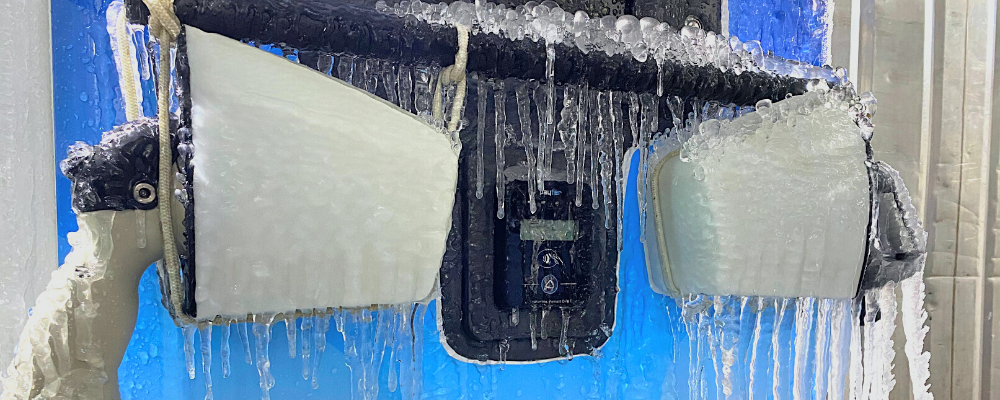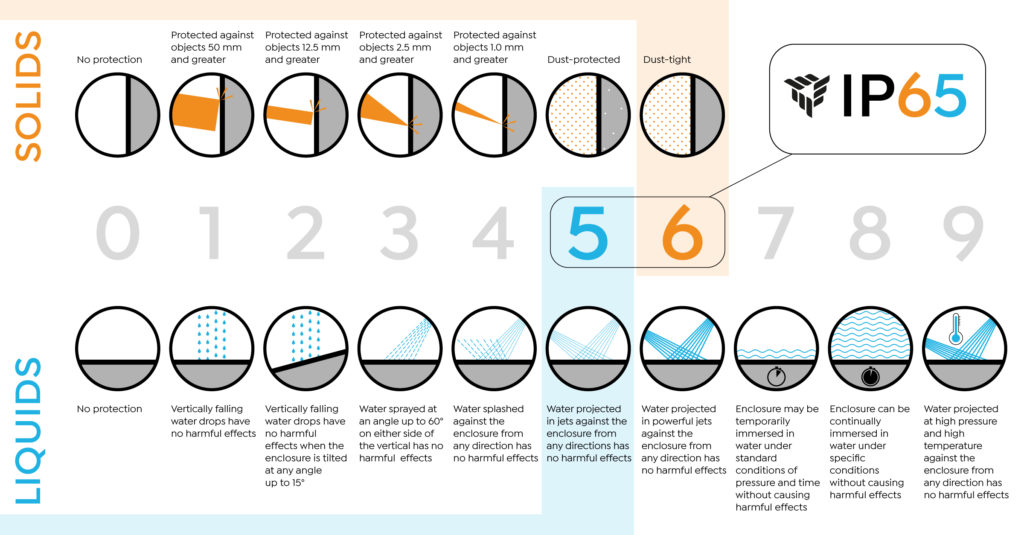What Is IP65 and Why Is It Important?

In 2013, Tritium launched the RT50. This 50kW charger created a pivotal shift in the industry by not only becoming the most compact direct current (DC) fast charger on the market, but also by becoming the first to achieve an IP65 rating. By achieving these milestones, Tritium opened the door for DC fast chargers to be installed in many new locations, environments, confined spaces, and conditions.
Since that time, Tritium’s product line has expanded but we’ve never forgotten our roots. By upholding the IP65 standard, Tritium can better protect our chargers’ integrity, produce a longer charger lifespan, and provide our customers with a charger built to withstand and thrive in some of the world’s harshest conditions. The IP65 rating enables Tritium to provide significant benefits to our customers, but what does it mean exactly?
The History of the IP Code
Companies have long developed ways to keep contaminants from getting inside their products. Whether these contaminants are big, like tree branches, nuts, bolts, and fingers or small like dust, dirt, grease, snow, and water, companies have long realized that their products can perform better, last longer, and be more reliable if they’re protected from the world’s elements.
For many years, companies would claim that their product was ‘waterproof’ or ‘dustproof’, but there were no standards to define those claims. To prevent companies from misleading the public, a standard was needed to clarify what was meant when a product was described as waterproof, dustproof, etc.
To validate these “waterproof” or “dustproof” claims, the International Electrotechnical Commission (IEC) developed the Ingress Protection (IP) code. The goal of this code is to clearly define levels of product protection from particles (big or small) or water, from gaining ingress (i.e., entering) your product.
Deciphering the IP Code
The IP code is a system used to grade the resistance of an enclosure when exposed to particles (like dust) or liquid. The code always starts with “IP” followed by a number between 0 and 6 to indicate protection against foreign objects, then a number between 0 and 8 to indicate protection against water. So, when Tritium states that the RTM75 is IP65-rated, that means that the RTM75 has achieved an IP rating of “6” against particles and “5” against liquid.
The numbers in the IP code have clear definitions to indicate the level of protection in each category. For example, using the table below we can see that the Tritium RTM75 is not only dust-tight, but is also protected from water projected in jets. This level of added protection gives charging station owners peace of mind that their investment will be protected during inclement situations, but why else is it important?

The Importance of IP65 in EV Charging
As transportation continues to electrify, adequate electric vehicle (EV) charger availability will be required to meet charging demand. Unlike the traditional fuel station, EV charging has the luxury of being able to be installed anywhere with a connection to an electrical grid. This opens immense opportunity to install charging not only where EV drivers travel, but also where they work and live. The possibilities are truly endless as retail properties, hotels and motels, workplaces, mining and construction sites, homes and apartments, and anywhere else with a grid connection can immediately become a charging destination.
Many chargers on the market only have an IP54 rating or lower, meaning that the charger is not dustproof and is only able to withstand splashes of water. These chargers usually have vented openings to draw outside air into the charger to cool it. Since IP54-rated EV chargers draw air into the system but are not dust-sealed, they typically require dust and dirt filters to keep particles out of the electrical systems. And, like most filters, these need to be regularly changed, adding service costs. Similarly, since IP54 enclosures are only splashproof, they run the risk of suffering issues or even failure in the event of exposure to water or severe weather.
In markets where EV chargers are heavily deployed, early indications show that the combination of dust and moisture ingress can result in early ageing of the power electronics system, sometimes reducing the lifespan to as little as three years. Since a normal lifespan of an EV charger is around 10 years, that is a 70% reduction!
DC Everywhere
To truly meet driver demand, DC fast charging is not only necessary but required. EV drivers can’t always afford to leave their vehicle charging for many hours. They have places to go, people to see, and appointments to keep. A greater level of speed and convenience is required to enable longer trips, provide a safety net, and provide those who may not be able to access charging at home with the opportunity to go electric. And, as drivers we’re accustomed to the gas and petrol station experience, with the ability to fuel our vehicle in 10 minutes or less. DC fast charging provides all these things, while simultaneously untethering drivers from the fuel station experience.
Not only does DC fast charging provide the best charging solution along highways and corridors, but it has great potential to be integrated as part of daily life. Instead of the current fueling destination model used in the petroleum and gasoline industry, public charging provides the opportunity for a fill up anywhere. Whether you’re getting groceries, picking up dinner, visiting a friend or family, or even going to the doctor, you can plug your EV into a DC fast charger and leave with a full charge.
The Tritium Difference
Since DC fast chargers can be installed anywhere, they also need to be built to thrive anywhere. Whether the property is on a beach, in the mountains, or in the desert, the charging solution needs to be able to withstand snow, rain, dust, wind, heat, cold, and any other environmental condition.
At Tritium, that’s why we have invested in achieving an IP65 rating for all our chargers. If a charger can be built sufficiently resilient and robust, EV drivers can feel more confident pulling up to a charging station, and charging station owners can rest assured knowing their investment is always online, furthering e-mobility around the world. By building and testing our chargers for the world’s toughest and most extreme conditions, we can better ensure that EV drivers can achieve a quick, efficient, and reliable charge every time they pull up to a Tritium charger.
Want to Learn More?
Contact our sales team to learn more about Tritium’s chargers and the IP65 difference.